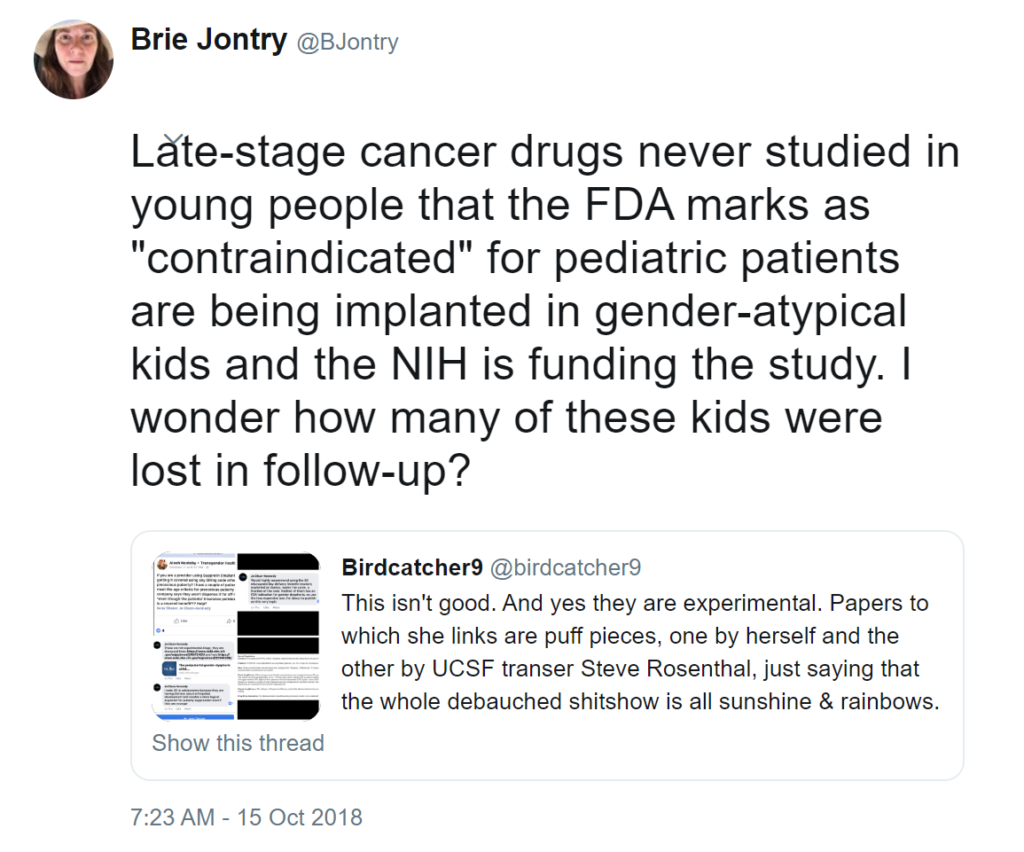 4thWaveNow, one of the three survey respondent recruitment sites for the badly flawed study of an alleged new “rapid onset gender dysphoria” condition, has long served as a clearinghouse for questionable notions about puberty-blocking medications used for transgender youth. These include:
4thWaveNow, one of the three survey respondent recruitment sites for the badly flawed study of an alleged new “rapid onset gender dysphoria” condition, has long served as a clearinghouse for questionable notions about puberty-blocking medications used for transgender youth. These include:
- Scaremongering about the effects of puberty blockers on AMAB genital maturation and the feasibility of vaginoplasty. (Adolescent trans girls on puberty blockers have had successful vaginoplasties since blockers were first used in the early 1990s, and numerous techniques for construction of a vulva and vagina – using whatever amount of tissue is available – have long been used in trans women who transitioned both in adolescence and in adulthood.)
- Claiming that the use of puberty blockers in gender-dysphoric youth forestalls the physical development that would result in that dysphoria desisting for many of them. (Puberty blockers are already withheld in the earliest stages of puberty so that youth can experience those initial changes, helping to indicate whether their dysphoria will abate or worsen and whether they should discontinue treatment.)
- Alleging that adolescent gender dysphoria is part of the “normal struggles” of puberty, a crucial developmental task or “identity crisis” in this stage of life that must be allowed to proceed uninterrupted for the sake of reaching their “adult potential”. (Clinical levels of gender dysphoria are extremely uncommon in the general population of adolescents, and there is no evidence that allowing gender dysphoria to remain untreated will result in anything resembling healthier outcomes or improved personal and psychological adjustment.)
Such a list of the community’s misrepresentations on this topic could continue indefinitely. However, in addition to their shaky grasp of affirming treatment for trans youth and its outcomes, there is a more fundamental issue here: the staff of 4thWaveNow may not actually know which medications they’re talking about.
4thWaveNow’s spokesperson Brie Jontry, a parent respondent to the “ROGD” survey who has previously called transition “enslaving” and “physician-assisted self-harm”, seems to believe she’s now stumbled upon evidence of irresponsibility by practitioners treating trans youth. On October 15, Jontry shared a screenshot of clinicians discussing insurance coverage of the Vantas implant for trans adolescents, and described this as follows:
Late-stage cancer drugs never studied in young people that the FDA marks as “contraindicated” for pediatric patients are being implanted in gender-atypical kids and the NIH is funding the study. I wonder how many of these kids were lost in follow-up?
Her tweet cites a UCSF lecturer in epidemiology who attacks UCSF pediatric endocrinologist Dr. Stephen Rosenthal of the Child and Adolescent Gender Center and calls him a “transer”. Have Jontry and this lecturer raised a valid concern here? Are these implants “late-stage cancer drugs never studied in young people” and contraindicated in pediatric patients? Let’s find out.
(Spoiler: no.)
The Vantas implant is described as “a 50-mg histrelin acetate drug core inside a 3.5 cm by 3 mm, cylindrical hydrogel polymer reservoir”, indicated “for the palliative treatment of advanced prostate cancer”. Histrelin acetate is a GnRH agonist that functions to suppress the production of sex hormones, and the implant is designed to release this medication continuously over 12 months. Vantas is “inserted subcutaneously in the inner aspect of the upper arm”.
Compare this to the Supprelin LA implant, which was also discussed by the clinicians in the cited screenshot. Supprelin LA is described as “a 50-mg histrelin acetate drug core inside a 3.5 cm by 3 mm, cylindrical, hydrogel polymer reservoir”, indicated “for the treatment of children with central precocious puberty” and designed to deliver this medication over 12 months. Supprelin LA is “inserted subcutaneously in the inner aspect of the upper arm”.
These are the same medication: histrelin acetate. Both implants contain the same dosage of that medication delivered in the same manner for the same duration. The NIH’s National Library of Medicine describes both Vantas and Supprelin in the same way, referring to them interchangeably as “histrelin implant”. This is because they are interchangeable.
Is this a “late-stage cancer drug”? Yes. It is also a central precocious puberty drug – a puberty blocker. Was it “never studied in young people”? No. The histrelin implant, as Supprelin LA, is specifically approved for use in children. Is the Vantas implant “contraindicated for pediatric patients”? No. Jontry and the UCSF lecturer provide a screenshot describing Vantas as “not indicated for use in pediatric patients”. “Not indicated” is not the same thing as “contraindicated”. Vantas was approved with an indication for use in advanced prostate cancer, while Supprelin LA was approved with an indication for use in precocious puberty, but this is still the same medication delivered in the same way.
The fact that two medications containing the same drug are on the market for two different purposes is an artifact of various interacting elements of the larger healthcare system – it does not represent any sort of difference inherent to the drug itself, because it is the same drug in both cases. Similarly, Prozac is indicated for the treatment of major depression, while Sarafem is indicated for the treatment of premenstrual dysphoric disorder; both Prozac and Sarafem are oral fluoxetine. The chief difference between Supprelin LA and Vantas is that while Supprelin LA costs around $35,000, Vantas costs about $4,200 – a substantial difference that was emphasized by the clinicians in the cited screenshot. 4thWaveNow has previously described puberty blockers as a “very expensive drug treatment”; it is unclear why they would take issue with clinicians actively working to reduce that expense.
Jontry’s alarmist description of Vantas as “late-stage cancer drugs never studied in young people that the FDA marks as ‘contraindicated’ for pediatric patients” is akin to describing generic versions of EpiPen as “dangerous central nervous system stimulants used in advanced cardiac life support”. Such rhetoric obscures the objective facts in order to advance a perspective that is primarily ideological, flipping a total non-issue to extract value in public fright. Consider that Jontry is among the “ROGD parents” whose perceptions of their children’s gender-dysphoric symptoms and gender identity development are assumed to be totally credible by the ROGD study, even as they lack the most basic understanding of issues involving trans youth. Conversely, 4thWaveNow’s commenters have dismissed my own work as that of a “high school dropout” and “pornographer”. The 4thWaveNow community may now amend those illustrious accolades: I’m the high school dropout and pornographer who knows what Vantas is. ■




